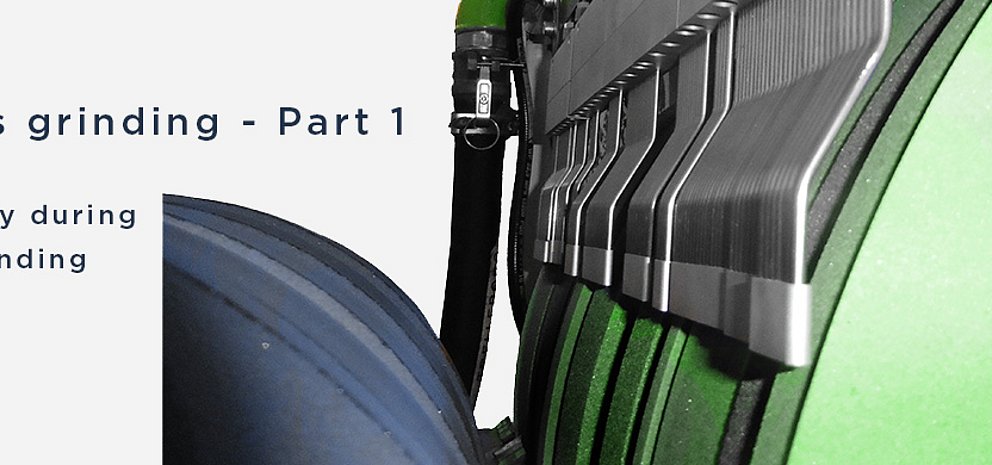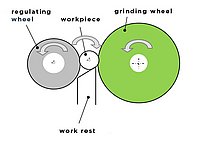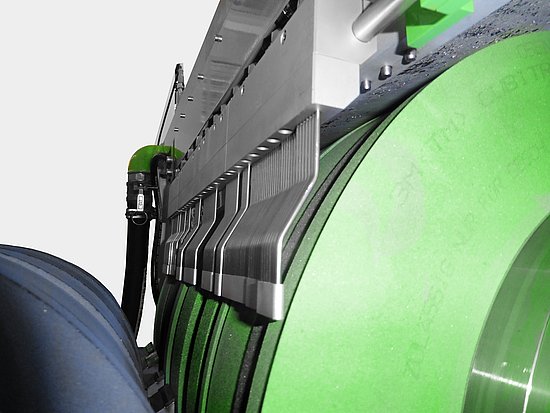Coolant supply during centerless grinding
Among the cylindrical grinding processes, centerless processes occupy a special position with regard to their process design and range of application. The main field of application of centerless grinding is in large-scale and mass production.
While the workpiece is guided in its axis of rotation during grinding between centers, its position during centerless grinding is determined by a three-point bearing on the grinding wheel, regulating wheel and support rail components.
The component is simultaneously guided and machined on its circumferential surface.
Centerless plunge grinding
In centerless plunge grinding, the components to be ground are fixed in position via an axial stop and in height on a support rail. The grinding wheels are usually mounted in pack arrangements on the grinding spindle and grind all the functional surfaces of the component to be ground in one process step in a plunge-cut grinding process. This saves time. The component is supported by a regulating wheel to prevent it from bending. At the same time, the regulating wheel brakes the component to a dimension appropriate for the process.
The cooling lubricant supply in centerless plunge grinding has various tasks:
- Supply of all active grinding wheel coating areas that come into direct contact with the component
- Cleaning of the active abrasive coating areas from material-related clogging
- Proper penetration of the air cushion rotating with the grinding wheel
- Avoidance of aqua-planing effect due to excess supply of cooling lubricant
- at the contact zone between component and support rail
- at the contact zone between component and regulating wheel
- Cooling of the dressing process
- Discharge of the grinding sludge from the machine bed
- Cooling of the machine bed / machine structure
- Cooling of the grinding spindle
- Cleaning the measuring devices in the engine room
All these different supply tasks must be taken over by a properly designed cooling lubricant without foaming and improper deposits in the machine room. The purity of the cooling lubricant for centerless grinding should not exceed a gravimetric residual dirt content of 50 mg/liter. This gravimetric residual dirt content is measured with a membrane (pore size max. 5µm).
The number of particles in different size ranges is determined by DIN ISO 4406 (for emuslions) and NAS classes (for oils). We provide more detailed information on this in our technical seminar Avoiding grinding burns.
The Grindaix coolant nozzle technology significantly targets tasks 1 to 3:
- Supply of all active grinding wheel coating areas that come into direct contact with the component
- Cleaning of the active abrasive coating areas from material-related clogging
- Proper penetration of the air cushion rotating with the grinding wheel In centerless plunge grinding, partial areas of the component are machined in the angular plunge cut on face shoulders when the support ruler is set at an angle
In centerless plunge grinding, partial areas of the component are machined in an inclined plunge cut on flat shoulders when the support ruler is set at an angle.
In this case, high contact lengths occur between the component and the grinding wheel, which make it difficult to supply the grinding point with cooling lubricant. In this case, Grindaix uses a patented nozzle principle (see also the GRX-X All in One nozzle), in which the abrasive coating areas of the grinding wheel are supplied separately. The air cushion rotating with the grinding wheel is diverted via a first nozzle stage. In a second step, the grinding wheel is cleaned. The coating appears fresh, clean and remains free-cutting for longer without the need for dressing. In a third step, free pore spaces of the grinding wheel are impregnated with cooling lubricant immediately before the grinding wheel engages with the component. In this way, the grinding wheel itself virtually displaces the cooling lubricant into the grinding zone. The last and fourth task of the Grindaix patented solution is process cooling from the outside, which can now be achieved much better on shoulder grinding areas due to the fact that the air cushion has previously been significantly weakened.
To prevent these nozzle systems from becoming resinous (when emulsion is used), they must be briefly blown out after use via a separate pressurized air supply to the Grindaix nozzles. For this purpose, a compressed air valve is briefly opened directly by the machine control system after process control.
Centerless throughfeed grinding
In centerless through-feed grinding, the component does not remain on the support rail, but moves across it through the gap between the grinding wheel, regulating wheel and support rail. In the process, its outer diameter is to be ground to a required dimension. The advantage of this process is that the components can be moved very quickly through the grinding area without component changeover times. This saves time.
The removal of the workpiece allowance must therefore be distributed over the available grinding wheel work. Nevertheless, a wear characteristic of centerless throughfeed grinding processes will form along the grinding wheel axis, which is also known as "centerless hole" (Fig. 2). This wear will form regardless of whether the grinding gap taper is produced by appropriate profiling of the grinding wheel or pivoting of the regulating wheel [KOEN84].
According to the axial feed per workpiece revolution, the grinding wheel can be divided into sections parallel to the axis. In the grinding zone, each section of the width must machine a part of the workpiece allowance z. If a grinding zone section wears out, the following section will have workpiece material on it in addition to the part of the stock allowance that could not be machined by the previous section. The grinding wheel wear in the grinding zone increases in the feed direction, since each grinding zone section must compensate for the wear of the previous section. In the spark-out zone, the wear decreases again, which is why the centerless hole is characteristically formed between the grinding and spark-out zones. This means an additional task for the cooling lubricant supply. The coolant supply is handled differently (in pressure and supply quantity) over the grinding wheel width. There are three coolant supply areas, see Fig. 5.
The tool passes through the areas of roughing, finishing and finally spark-out in the grinding gap of centerless throughfeed grinding. It is precisely in the run-in of the workpiece into the grinding gap that there is an abrupt increase in material removal. This area is called the roughing zone in which the so-called roughing is performed. Roughing is understood to mean maximum machining of the stock allowance without taking into account the surface quality that is formed in the process. Here, cooling must be particularly strong, as the high rate of decomposition results in correspondingly high temperatures. On the one hand, the component must be protected against thermal damage, and on the other hand, the wear formation on the tool side of the aforementioned "centerless hole" can be significantly reduced by improved cooling. The tool wears less quickly, and the process can be kept stable for longer. This increases the profitability of the manufacturing process.
Similar to centerless plunge grinding, the patented approach of the multi-function nozzle, especially in the roughing area of a grinding wheel, succeeds in maximizing the proper supply of cooling lubricant to the grinding process via the four-function approach.
- Reduction of the air cushion influence (attenuation)
- Cleaning of the active abrasive coating areas from material-related clogging
- Impregnation of the rough grinding wheel lining
- Proper penetration of the cooling jet of the air cushion rotating with the grinding wheel
The supply of the finishing and spark-out areas of a grinding wheel during centerless through-air grinding can be conventionally supplied via the existing Grindaix nozzle solutions (needle nozzle, centerless nozzle). In the finishing area of the grinding wheel, in contrast to the roughing area, attention is paid to surface formation rather than material removal. The supply of cooling lubricant to the finishing wheel is significantly lower (pressure/quantity) than in the roughing area. In the spark-out area, hardly any cooling lubricant is required, since very low metal removal rates occur here, if at all. As a result, no thermal damage to the component surface is to be expected.
Each Grindaix nozzle solution is designed and professionally optimized to your process. The following optimization goals are in the foreground:
- Reduction of the risk of grinding burns with maximum productivity
- Stabilization of the grinding process (robustness) due to wear reduction effects on the grinding tool
- Reduction of the cooling lubricant requirement - Relief of the coolant filtration system
The grindaix team looks forward to working with you to push your centerless grinding process to its performance limits!
Sources
KOEN84 : König, W.; Schleich, H.; Yegenoglu, K.; Stuckenholz, B.: High performance grinding with CBN-wheels, Biennial International Machine Tool Technical Conference – Session 5, S. 58 – 96, IMTS 84, Chicago, USA
These articles from our magazine might also interest you:
Reduce CO2 emissions
Climate change, as described in a very detailed risk research by the European financial institutions, poses an unprecedented challenge to the governance of global socio-economic and also financially acting systems.
Advantages of Coolant Monitoring Systems
Coolant monitoring systems can significantly contribute to increasing reliability and efficiency by collecting and evaluating a wide range of measurement and condition data in the coolant system.
Zero Emission Production
Zero Emission Production helps to reduce carbon dioxide emissions permanently while at the same time increasing the availability of production resources and avoiding the waste of operating materials.
ROI-Digitization Projects
The digitization of production units offers a wide range of possibilities for networking existing machines and systems. In this article, we offer you a brief orientation in the subject matter.









